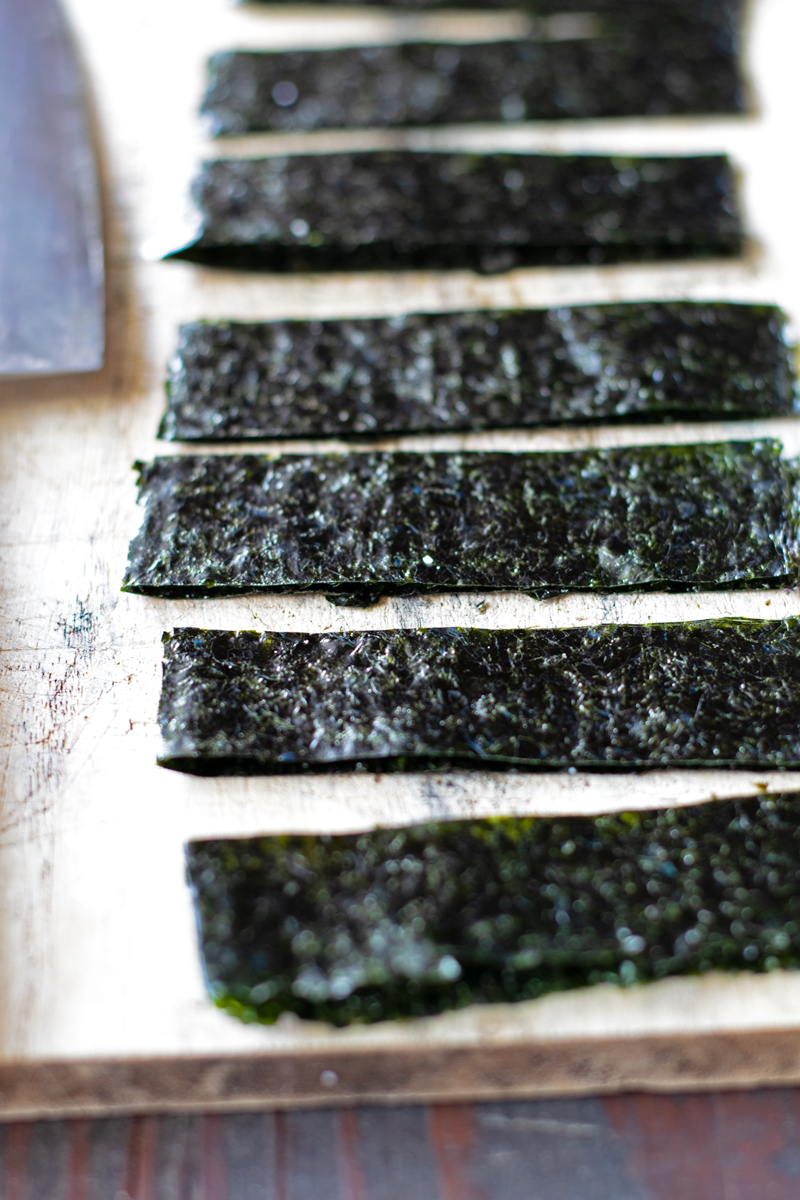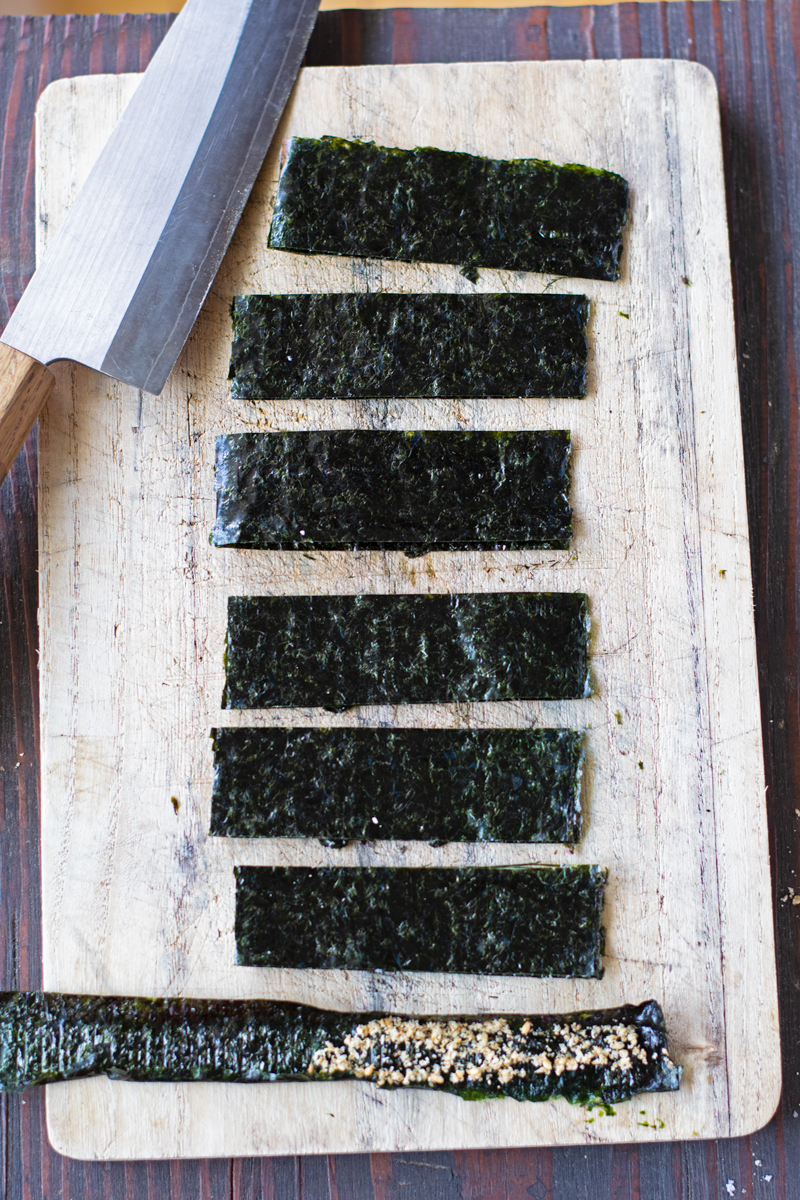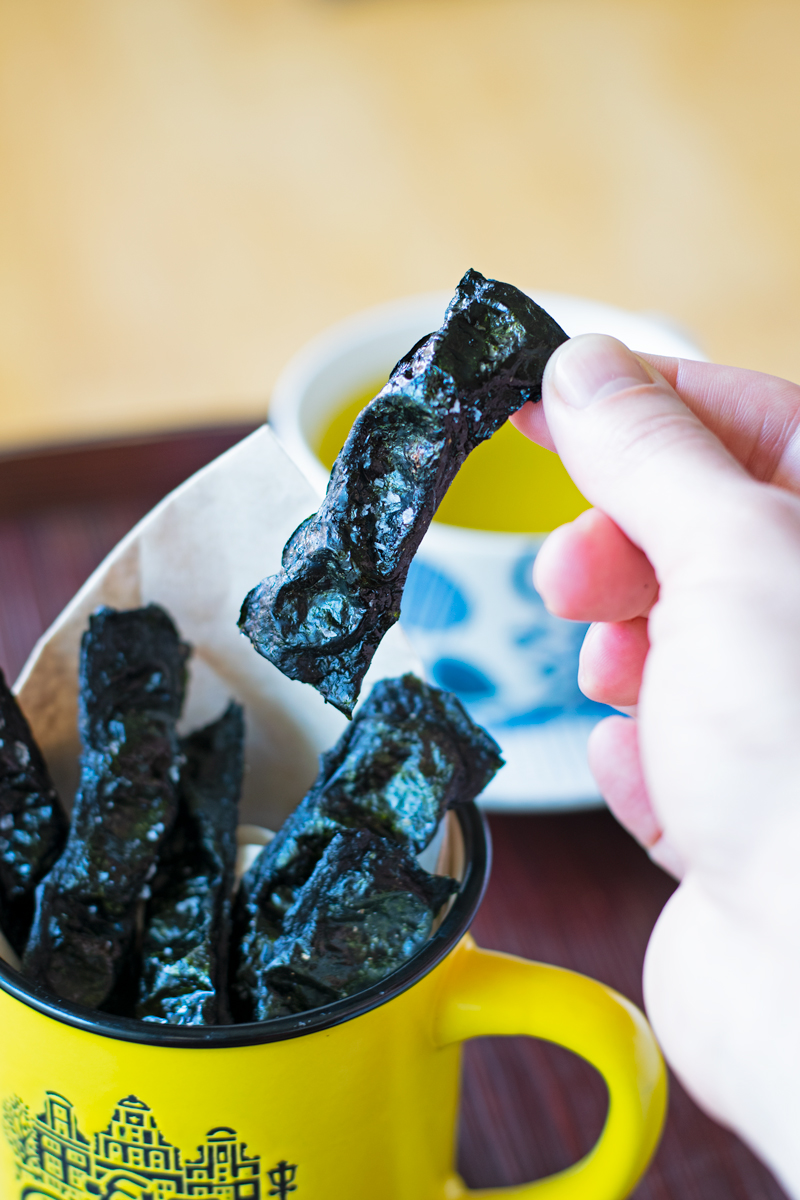Nowadays, you can even find those little packets of seaweed snacks at mainstream grocery stores like Whole Foods and Trader Joe's. But did you realize just how easy nori seaweed chips are to make at home?
Jump to Recipe
What is roasted seaweed?
Traditionally, roasted seaweed is very popular to eat in South Korea and Japan. Parents and grandparents in this part of the world grew up snacking on seaweed when they got home from school.
It's used as an ingredient for sushi rolls, wraps, salads, side dishes, and topping for ramen. It's also eaten plain as a snack or with rice.
The roasted seaweed sheets you buy from your local grocery store are made from nori. Nori is the Japanese name for a variety of seaweed that's dried into sheets. In Korea, the same variety of seaweed is called gim.
To take a deep dive, check out my essential guide to nori seaweed.
It will answer all your other questions. It’s the most extensive guide to Japanese nori in English on the internet.

How do they make roasted seaweed snacks?
Most roasted seaweed snacks are made with only three simple ingredients: nori sheets, a little bit of oil, and a bit of salt. That's it.
The seaweed is lightly toasted in an oven, coated with a small amount of oil, and sprinkled with a pinch of salt.
This video featuring Annie Chun and GimMe seaweed, shows how commercial seaweed snacks are made.
Roasted seaweed snacks in Korea are typically coated with sesame oil or perilla oil. Some of the newer brands based in the US use olive oil instead, or even avocado oil.
They've gotten creative with the flavors: wasabi, teriyaki, chili lime, Korean BBQ, Sriracha, and Maui Onion.
You can check out my simple recipe for making your own homemade roasted seaweed below.
It's an easy way to make your own. Even better than store-bought… you get to eat them while they're still warm out of the oven!

Ingredients
1) high-quality sheets of nori seaweed (find my recommended brands inside my guide to seaweed)
2) water
3) ground sesame seeds
4) your choice of oil (sesame, extra virgin olive oil, avocado, etc.)
5) fine-grained sea salt (flaky sea salt may be too big to stick to the seaweed)
6) optional: other added flavors like lemon juice, shichimi togarashi, soy sauce, etc.
Kitchen Equipment Needed
1) sharp knife or kitchen scissors
2) cutting board
3) pastry brush
4) small bowls or cups
5) oven (or try a toaster oven if you don’t own an oven)

Is it healthy to eat roasted seaweed?
Yes, roasted seaweed is a sea vegetable. That means it absorbs minerals from the ocean.
Nori is actually a very nutrient-dense food. It contains calcium, vitamin C, vitamin B1, B2, and it's high in fiber.
The catch is the serving size is small. So that means you won't get a lot of added nutrition by eating the recommended serving size.
If you're eating more than one or two serving sizes, it's likely that you're getting too much iodine.

Is it ok to eat roasted seaweed every day?
Some people describe it as the potato chips of the sea. They can be equally addicting. But they're a lot healthier.
Even the picky eaters in my kindergarten class love this stuff. But is it ok for them to eat it every day? Hmm...
There are a few things about seaweed that you should know before you add it to your diet.
Seaweed is high in iodine. Iodine is essential for our body to function. However, too much iodine can cause problems. Especially, if you have some thyroid issues, you should consult your doctor or nutritionist first.
Also, depending on the quality of the water where your nori was grown, it could contain contaminants such as heavy metals.
So, yes, for most people, it can be safe to eat roasted seaweed every day. While I'm a huge fan of eating this stuff, I wouldn't go overboard.
1 package a day is probably ok. (Ask your doctor.) 2-3 packages or more a day... I don't recommend it, especially for young children.
There's probably a good reason the portion sizes are the size that they are: about 5 oz.

Roasted Seaweed Recipe
Ingredients
- 1 sheet dried nori seaweed
- water a small cup
- 1 teaspoon sesame seeds
- 1 teaspoon sesame oil
- 1 pinch sea salt
Instructions
- Preheat over to 160 C (320 F).
- Cover a baking sheet or tray with aluminum foil. Set aside.
- Using a pasty brush, lightly coat the foil with a thin layer of sesame oil.
Making nori chips
- Lay one sheet of nori seaweed, rough side facing up, on a cutting board.
- Using your hands, fold the sheet of seaweed in half once.
- Press down on the crease with your hand until the folded seaweed lays flat.
- Using a sharp knife, cut seaweed into strips approximately 3 cm wide. Each strip should have the fold at one end.
- Open one of the seaweed strips.
- Using a pastry brush, lightly apply water to the perimeter of the strip.
- Sprinkle ground sesame seeds on one side of the strip, except for the edges that you brushed with water.
- Fold the seaweed strip together to sandwich the ground sesame seeds on the inside.
- Using your fingers, press down along the edges until they stick together and seal the ground sesame seeds on the inside.
- Repeat the same process with each nori strip.
- Using your fingers or chopsticks, transfer each folded seaweed strip onto the aluminum foil.
Baking the nori strips
- Put baking sheet into the pre-heated oven.
- Bake for about 2 minutes, until the seaweed changes to a lighter green color, begins to curl, and puffs up.
- Keep your eyes on the oven to make sure the seaweed strips don't burn.
- Once the seaweed starts to curl and turn crisp, remove baking pan from the oven.
- Using your pastry brush, lightly coat each seaweed chip with sesame oil. A few drops of oil per chip is enough.
- Sprinkle each chip with a small pinch sea salt.
- Pick up each chip with chopsticks or an alternative utensil. Place baked seaweed chips in a cup or bowl.
- Serve warm.
What do you do with roasted seaweed?
This recipe is just meant to be a healthy snack.
In East Asia, roasted seaweed most commonly goes with rice.
It's used to wrap sushi rolls in Japan and gimbap rolls in South Korea.
The triangle-shaped onigiri (rice ball) is another rice-seaweed combo you can find at every convenience store in Japan.
You'll find it tucked in Korean rolled egg omelets. It's a staple ingredient in Korean bibimbap.
In Japan, you'll find it cut into small pieces, topping a side dish or mixed into a salad. You'll even find rectangular strips lining your bowl of miso ramen.
Other recipe ideas for roasted seaweed chips
You can get even more creative with these seaweed snacks. Cut them up to sprinkle on white rice like furikake, add them on top of a Japanese mizuna salad with sweet sesame oil and rice wine vinegar dressing, or add to the top of ochazuke or miso soup.

How to store roasted seaweed snacks
Exposure to air will make your crispy seaweed go limp and soggy.
It's important to keep your dried seaweed's exposure to a minimum.
Store in a small airtight container, preferably a tightly sealed Ziplock bag. If using resealable plastic bags, be sure to squeeze out as much of the air out as possible.
Advice for when you are making your own roasted seaweed snacks:
Once you open a package of nori seaweed, I recommend keeping the bag of nori sealed in the refrigerator.
Take out only the number of sheets you plan on eating in one batch. Store the remaining sheets in the fridge in a sealed Ziplock bag.

Other healthy snacks:
1) Korean seaweed chips, aka gim bugak, is made with glutinous rice paste.
2) Inspired by gim bugak, my healthier recipe (baked, not fried) are made with sesame seeds and sliced almonds.
4) Find my favorite store-bought seaweed snacks inside my "essential guide to nori seaweed"
Also, here are my blog posts on healthy Japanese snacks:
2) health Japanese snacks from the convenience store
3) my free guidebook "The Healthy Snacker's Guide to Japan"





Meg says
Hi! Can I replace nori with roasted seaweed in a recipe for a green onion salad to serve with ramen?
Matt says
Hi Meg! That sounds like it would work. Is it seasoned roasted seaweed? Either way, dried seaweed goes well with both green onions and ramen.